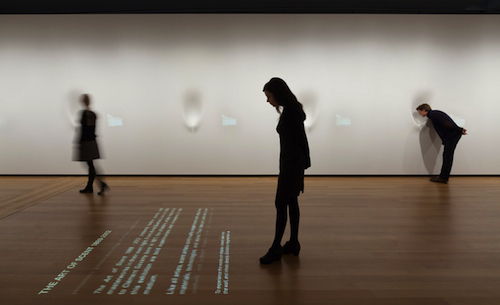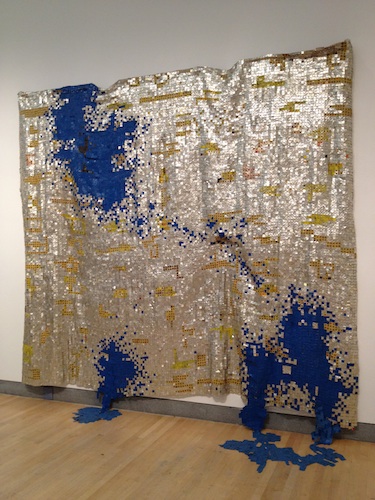
HCCC Curatorial Fellow, Kathryn Hall, reports on the CAA Conference in New York City, February, 2013.
Last month, New York City welcomed the 101st Annual College Art Association (CAA) Conference. Drawing in over 6,000 CAA members, the conference hosted a motley international crew of artists, art historians, students, educators, critics, gallerists, and curators. This year’s CAA Conference remained the who’s who of the academically minded art world, as leaders within the field of art, craft, and design presented new material in over 200 sessions.
Providing an open forum for ideas, networking, and new collaborations, the conference was a panacea for curator’s block. Extending out into the boroughs of New York, the conference encouraged its members to take advantage of the cultural capital through partnerships with museums and galleries. HCCC Curator, Anna Walker, and I took full advantage of these opportunities by parceling our time to meet with artists, colleagues, and to explore several new exhibitions.
Sessions
Armed with an agenda, Anna and I strategically tackled the session schedule. Between the two of us, we attended several different sessions in hopes to broaden our knowledge base, reserving time for discussion over food and coffee. With many sessions devoted to specific topics in art history and theory, I attended several sessions outside the field that I felt would inform my work in the future.
Here are a few important sessions that pertained specifically to contemporary craft:
Towards a New Apprenticeship Model: the Case of Experiential Learning
Led by The Center for Craft, Creativity, and Design (CCCD), this panel discussion kicked off a new platform for apprenticeship models. Panelists were asked to share their experiences working as an apprentice, which in turn sparked a productive discussion about the future and stability of apprenticeship models in the United States.
Craft after Deskilling?
Buttressing the Critical Craft Forum’s panel, Craft in the Skill/Deskill/Reskill Debates, this session dissected some key issues regarding the current craft vocabulary as well as the dialectic that positions craft within material culture. Artists, curators, and historians raised some very loaded questions about this particular moment within contemporary craft. All together, the dialogue promoted a dialogical structure for craft, design, and art professionals that introduced the possibility for future collaborations between fields.
Exhibitions
Former HCCC Curatorial Fellow, Susie Silbert, traveled with me and Anna, and the three of us critically dissected several exhibitions. Our observations of the aesthetics, technical aspects, and educational material of each exhibition informs our work at Houston Center for Contemporary Craft (and elsewhere). Here are a few exhibitions that were of interest to us.
The Art of the Scent: 1889-2012
(November 20, 2012 through February 24, 2013)
Challenging one’s visually inundated expectations regarding exhibitions, the Museum of Art and Design dedicated an entire show to the sense of smell. As an exhibition concept, the exhibition was bold and innovative. The exhibition celebrated the olfactory arts and the development of perfume since the late 19th century. Penetrating the clean minimalist walls of the museum, 12 convex, curvilinear indentations highlighted 12 different perfumes; the space was devoid of visuals. Activated by state-of-the-art technology, visitors encountered each scent by leaning their face into each wall indentation, triggering a release of perfume.
NYC 1993: Experimental Jet Set, Trash and No Star
(February 13, 2013 through May 26, 2013)
Flooding every floor of the New Museum, this exhibition acts as a time capsule for the 1990s. Stepping into the foyer of the New Museum would be nirvana for any grunge fan. With “Smells Like Teen Spirit” playing in the background and a group of people decked out in baggy plaid flannel, one is immediately transported. Organized thematically by floor, this exhibition illustrates how the artists of the 1990s grappled with issues of AIDS, identity, violence, and prejudice.

Gravity and Grace: Monumental Works by El Anatsui
(February 8 through August 4)
The Brooklyn Museum’s retrospective of El Anatsui was monumental in its own respect. Large installations of the artist’s colorful patchwork made by hand, from recycled metal, fell to the floor like an old-world tapestry. Juxtaposed with several interviews of Anatsui, visitors were introduced to his collaborative process as well as some of the themes of his work.

The CAA experience provided me with plenty of food for thought to digest. I left New York revitalized with a few extra tools, contacts, and ideas to aid future exhibitions. I can say with confidence that the CAA conference is a necessary trip for any academically conscious professional working in the arts.
Kathryn Hall
Curatorial Fellow
Houston Center for Contemporary Craft

